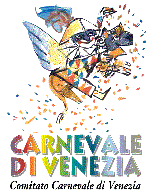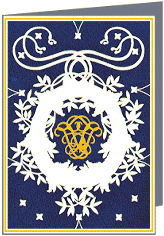TERZA PAGINA
Il Carnevale
di Venezia
Sera
Opere di Italiani
I Premi Nobel Italiani
La Rondine is published monthly by The Italian Club of St. Louis
President
Editor
Franco Giannotti
Internet Edition

|
|
|
|
|
|
Recap of February Meeting
|
Popular legend has it that Marco Polo (a sicilian, by the way) introduced pasta to Italy following his exploration of the Far East in the late 13th century; however, pasta can be traced back as far as the fourth century B.C., where an Etruscan tomb showed a group of natives making what appears to be pasta. The Chinese were making a noodle-like food as early as 3000 B.C. And Greek mythology suggests that the Greek god Vulcan invented a device that made strings of dough (the first spaghetti!). Pasta made its way to the New World through the English, who discovered it while touring Italy. Colonists brought to America the English practice of cooking noodles at least one half hour, then smothering them with cream sauce and cheese. But it was Thomas Jefferson who is credited with bringing the first "maccaroni" machine to America in 1789 when he returned home after serving as ambassador to France. The first industrial pasta factory in America was built in Brooklyn in 1848 by, of all people, a Frenchman, who spread his spaghetti strands on the roof to dry in the sunshine. |
March Program
The Four Pietas of Michelangelo Our March presentation, The Four Pietas of Michelangelo by member Prof. Anthony Perrone will be given in Italian. However, all questions during the presentation and any explanations and discussion afterwards will be in English. OK - so you say that you don't understand Italian. Sta tranquillo. We will provide everyone with written Italian and English versions of Tony's presentation. Given the superb quality of Professor Perrone's past presentations - these will definitely be worth saving. |
La Festa della Donna
Davide Maggiacomo
|
Il motivo per cui si festeggia la donna l'8 Marzo e` legato ad un evento accaduto agli inizi del secolo in New York City. Una piccola fabbrica, che aveva solo donne che lavoravano come operaie, venne occupata dalle stesse operaie per protestare contro il proprietario che le sfruttava. Il giorno 8 Marzo 1908 un incendio ( non si sa se fu' doloso) distrusse la fabbrica uccidendo 129 donne. Molti anni dopo si scelse questa data come festa della donna per simboleggiare il riscatto e la liberazione della donna nei confronti dell'uomo. Comunque, al giorno d'oggi, se si chiede ad una donna perche` si festeggia l'8 Marzo, nove donne su dieci non lo sanno. |
| (Translation by Barbara Klein):
Feast of the Woman In Italy (and many European countries) March 8 is
the Feast of the Woman. On this day men give women bouquets of mimosa flowers
or a mimosa cake. The mimosa flower symbolizes women because it is a very
delicate flower, but at the same time it is strong and resistant to the
cold days of winter. In addition, the evening of March 8, married women
leave their husbands at home and go out to dinner with their friends. |
Vice Consolato d'Italia Joseph Colagiovanni, Italian Vice Consul in St. Louis, has asked us to inform our members of his office hours on Saturday mornings at the Italia-America Bocce Club on the Hill. He maintains regular office hours at his offices downtown, but as an additional convenience, he also will be available one Saturday morning each month during 1998 between 10:30 and 12:00 a.m. at the Bocce Club (2210 Marconi Avenue). The dates are February 21, March 14, April 18, May 23, June 27, July 25, August 29, September 26, October 24, November 21, and December 12. If you have any questions, Mr. Colagiovanni may be contacted at (314) 259-2008 |
Buon Compleanno La Rondine
| It seems impossible but a year has passed since "La Rondine"
was born and we wish to express heartfelt thanks to those members whose
hard work and dedicated efforts each month have made this newsletter possible.
In particular, very special mille grazie to Editor, Mary Jo Bertani, to Luisa Flynn, for La Terza Pagina, and to Peter Puleo and Barbara Klein for all they do every month. Thanks also to Franco Giannotti for including La Rondine each month as a part of the Club's website. Thanks to Franco's efforts, La Rondine is available to internet users throughout the world. |
Italian Club Home Page
If you have access to the internet, and haven't already visited the
Italian Club's world wide web site be sure and try it soon. The address
is:
In addition, Franco has provided useful links enabling you to connect easily to several Italian web sites including Italian newspapers, magazines, sport results, etc. Please pass our web address along to anyone you know who is interested in such information - and don't forget your friends and acquaintances in Italy (or anywhere else in the world for that matter). We have a number of people overseas that follow our home page. |
|
Italian Genealogy Conference
| The conference on Italian genealogy research, sponsored jointly by
the Italian Club, the Sicilian Cultural Association, and the St. Louis
Genealogical Society at the St. Louis County Library on February 28, was
a great success. Over 75 people attended (continued on page 4) including
many Italian Club members. Special thanks and congratulations to Italian Club Vice President Peter Puleo, who was instrumental in the organization of the conference and also gave a terrific presentation describing his practical experiences in tracking down his Italian ancestors in his home town of Cinesi, Sicily. Thanks and congratulation s also to John Forti of the Sicilian Cultural Association, and Mrs. Ann Fleming, President, St. Louis Genealogical Society. John and Ann both spoke and helped organize the conference as well. |
La Traviata
at the Chicago Lyric Opera and a weekend in Chicago!
| Does that sound like a great time to you? If
so, we would like to know. Member Luisa Flynn, who normally has
her hands quite full producing our "La Terza Pagina" is
investigating such a trip for Club members. We need to know if there would
be sufficient member interest to warrant pursuing the project further.
The only date for which group tickets are still available is Friday, December 18, 1998. At this point we can't tell you anything definite about cost but essentially it would involve traveling to Chicago on Friday, attending the performance that evening, spending Saturday there with return on Sunday. If you definitely would be interested (remember it would be one week before Christmas), please call Luisa at 993-9230 as soon as possible. |
Reminders
|
If you are interested in helping either adults or children learn the Italian language, please contact Joe Torrisi at Shaw Community School at 776-4327. |
|
The Gateway City Big Band will hold a benefit dance for St. Jospeh's Shrine on April 18. Please contact Dolly Randazzo for tickets at 867-3523. |
| Monthly Meetings
Don't forget to call 644-1645 one or two days ahead to make meeting reservations. Also, remember the Italian language mass at St. Ambrose on the Hill. First Sunday of each month at 11:00 AM |
|
|
|
IL CARNEVALE DI VENEZIA
E’ stata tutta dedicata a Giacomo Casanova l’edizione ‘98 del Carnevale di Venezia (18-24 Febbraio) che ha aperto le celebrazioni del bicentenario della morte del grande amatore del secolo dei lumi.
Per l’occasione è venuto da San Pietroburgo Mihail Chemiakin
che ha realizzato appositamente per il Carnevale il Monumento Casanova,
inaugurato in Piazza San Marco sabato 14 febbraio.
Il programma ‘98 ha puntato sulla qualità, cioè non sull’invasione della città ma su atmosfere particolari, restituendo il Carnevale alle maschere. Tra le manifestazioni, gli spettacoli teatrali de La Stagion del Carnevale: al museo Ca’ Rezzonico Gigi Proietti in Confessione di Casanova; al teatro Goldoni, Aldo Reggiani in Il ritorno di Casanova; e Don Giovanni di Mozart nella messa in scena del Salzburger Marionetten Theatre.
Dopo una manifestazione in piazza San Marco, il Carnevale è stato aperto con un grande corteo di maschere e si è concluso con il grande ballo Il mondo all’incontrario, ovvero la festa dei pazzi. Nelle giornate intermedie, altri balli ed altre sfilate di maschere e artisti, cortei sul Canal Grande, il Carnevale per i bambini a San Polo, e le feste nei palazzi.
Antonello ebbe cinque figli maschi che si unirono al padre e insieme produssero moltissime sculture che, benché tendessero ad essere un po' commerciali, rivelano tuttavia una straordinaria raffinatezza e fluidità, come dimostra la statua di Santa Caterina.
Questa statua, che pare facesse parte del gruppo di sculture che adornavano la tribuna della cattedrale di Palermo, viene attribuita ad Antonello nella concezione e a lui e al figlio Antonino (1514-1574) nell'esecuzione. A differenza di altri santi scolpiti dai Gagini, l'identità della santa è immediatamente riconoscibile come Santa Caterina di Alessandria; nella mano sinistra tiene un libro, simbolo del suo intelletto; nella mano destra, che è andata perduta, teneva la spada, simbolo del suo martirio e decapitazione. La santa era venerata non solo per il suo coraggio, ma anche per la sua bellezza, come è evidente dal volto ovale e sereno, la bocca ben delineata, gli occhi a mandorla, il collo elegante e i capelli che le scendono con grazia sulle spalle. La delicatezza del viso contrasta con la parte inferiore del corpo, che è scolpito con meno raffinatatezza. Il suo piede sinistro, che calca la testa dell'imperatore Massenzio, suo esecutore, simboleggia il trionfo del cristianesimo sul paganesimo.
SERA
|
Pare che il vento abbia strappato un biondo Pare che il mare abbia sospinto l'onda Diego Valeri |
OPERE DI ITALIANI AL MUSEO DI ST. LOUIS
11. Antonello e Antonino Gagini. Santa Caterina di Alessandria. (Marmo, circa 1535)
| La scultura siciliana della seconda metà del Quattrocento è dominata dai Gagini, una famiglia di scultori provenienti dalla Lombardia il cui capostipite, Domenico, era emigrato in Sicilia nel 1460. Il suo figlio più giovane, Antonello (Palermo 1478-1536) divenne il più importante e prolifico scultore del Rinascimento siciliano ed esercitò una profonda influenza non solo in Sicilia ma anche nella vicina Calabria. |
I PREMI NOBEL ITALIANI
Click on names for more information
 |
|
|
|